Repeatability of Inertial Measurements of Spinal Posture in Daily Life
Abstract
1. Introduction
2. Materials and Methods
2.1. Participants
2.2. Experimental Set Up
2.3. Experimental Procedure
2.4. Data Processing
2.5. Outcome Measures and Statistical Analysis
2.6. Reference Posture Estimation
2.7. Data Exclusion
3. Results
3.1. Task Repeatability
3.2. Real-World Data Quality
4. Discussion
4.1. Comparison of Methods to Compute the Reference Posture
4.2. Exclusion of Data Caused by Magnetic Interference and Other Errors
5. Conclusions
Supplementary Materials
Author Contributions
Funding
Institutional Review Board Statement
Informed Consent Statement
Data Availability Statement
Conflicts of Interest
Abbreviations
| IMU | Inertial Measurement Unit |
| ICC | Intraclass Correlation Coefficient |
References
- Żurawski, A.Ł.; Kiebzak, W.P.; Kowalski, I.M.; Śliwiński, G.; Śliwiński, Z. Evaluation of the Association between Postural Control and Sagittal Curvature of the Spine. PLoS ONE 2020, 15, e0241228. [Google Scholar] [CrossRef]
- Chow, D.H.K.; Leung, K.T.Y.; Holmes, A.D. Changes in Spinal Curvature and Proprioception of Schoolboys Carrying Different Weights of Backpack. Ergonomics 2007, 50, 2148–2156. [Google Scholar] [CrossRef]
- Ishikawa, Y.; Miyakoshi, N.; Kasukawa, Y.; Hongo, M.; Shimada, Y. Spinal Curvature and Postural Balance in Patients with Osteoporosis. Osteoporos. Int. 2009, 20, 2049–2053. [Google Scholar] [CrossRef]
- Lengsfeld, M.; Frank, A.; van Deursen, D.L.; Griss, P. Lumbar Spine Curvature during Office Chair Sitting. Med. Eng. Phys. 2000, 22, 665–669. [Google Scholar] [CrossRef]
- Alshehri, M.A.; van den Hoorn, W.; Klyne, D.M.; Hodges, P.W. Coordination of Hip and Spine in Individuals with Acute Low Back Pain during Unstable Sitting. Spine J. 2023, 24, 768–782. [Google Scholar] [CrossRef]
- Donisi, L.; Cesarelli, G.; Pisani, N.; Ponsiglione, A.M.; Ricciardi, C.; Capodaglio, E. Wearable Sensors and Artificial Intelligence for Physical Ergonomics: A Systematic Review of Literature. Diagnostics 2022, 12, 3048. [Google Scholar] [CrossRef]
- Caputo, F.; Greco, A.; D’Amato, E.; Notaro, I.; Spada, S. IMU-Based Motion Capture Wearable System for Ergonomic Assessment in Industrial Environment. In Advances in Human Factors in Wearable Technologies and Game Design; Ahram, T.Z., Ed.; Springer International Publishing: Cham, Switzerland, 2019; pp. 215–225. [Google Scholar]
- Abyarjoo, F.; O-Larnnithipong, N.; Tangnimitchok, S.; Ortega, F.; Barreto, A. PostureMonitor: Real-Time IMU Wearable Technology to Foster Poise and Health. In Design, User Experience, and Usability: Interactive Experience Design; Marcus, A., Ed.; Springer International Publishing: Cham, Switzerland, 2015; pp. 543–552. [Google Scholar]
- Petropoulos, A.; Sikeridis, D.; Antonakopoulos, T. Wearable Smart Health Advisors: An IMU-Enabled Posture Monitor. IEEE Consum. Electron. Mag. 2020, 9, 20–27. [Google Scholar] [CrossRef]
- Wang, W.; Adamczyk, P.G. Analyzing Gait in the Real World Using Wearable Movement Sensors and Frequently Repeated Movement Paths. Sensors 2019, 19, 1925. [Google Scholar] [CrossRef]
- Semwal, V.B.; Kumar, A.; Nargesh, P.; Soni, V. Tracking of Fall Detection Using IMU Sensor: An IoHT Application. In Machine Learning, Image Processing, Network Security and Data Sciences; Doriya, R., Soni, B., Shukla, A., Gao, X.-Z., Eds.; Springer Nature: Singapore, 2023; pp. 815–826. [Google Scholar]
- Tian, Y.; Meng, X.; Tao, D.; Liu, D.; Feng, C. Upper Limb Motion Tracking with the Integration of IMU and Kinect. Neurocomputing 2015, 159, 207–218. [Google Scholar] [CrossRef]
- Connolly, J.; Condell, J.; O’Flynn, B.; Sanchez, J.T.; Gardiner, P. IMU Sensor-Based Electronic Goniometric Glove for Clinical Finger Movement Analysis. IEEE Sens. J. 2018, 18, 1273–1281. [Google Scholar] [CrossRef]
- Simpson, L.; Maharaj, M.M.; Mobbs, R.J. The Role of Wearables in Spinal Posture Analysis: A Systematic Review. BMC Musculoskelet. Disord. 2019, 20, 55. [Google Scholar] [CrossRef]
- Robert-Lachaine, X.; Mecheri, H.; Larue, C.; Plamondon, A. Effect of Local Magnetic Field Disturbances on Inertial Measurement Units Accuracy. Appl. Ergon. 2017, 63, 123–132. [Google Scholar] [CrossRef]
- Chen, H.; Schall, M.C.; Fethke, N. Effects of Movement Speed and Magnetic Disturbance on the Accuracy of Inertial Measurement Units. Proc. Hum. Factors Ergon. Soc. Annu. Meet. 2017, 61, 1046–1050. [Google Scholar] [CrossRef] [PubMed]
- Robert-Lachaine, X.; Mecheri, H.; Larue, C.; Plamondon, A. Accuracy and Repeatability of Single-Pose Calibration of Inertial Measurement Units for Whole-Body Motion Analysis. Gait Posture 2017, 54, 80–86. [Google Scholar] [CrossRef] [PubMed]
- Fan, B.; Li, Q.; Liu, T. How Magnetic Disturbance Influences the Attitude and Heading in Magnetic and Inertial Sensor-Based Orientation Estimation. Sensors 2018, 18, 76. [Google Scholar] [CrossRef] [PubMed]
- Vitali, R.V.; McGinnis, R.S.; Perkins, N.C. Robust Error-State Kalman Filter for Estimating IMU Orientation. IEEE Sens. J. 2021, 21, 3561–3569. [Google Scholar] [CrossRef]
- Hickey, A.; Din, S.D.; Rochester, L.; Godfrey, A. Detecting Free-Living Steps and Walking Bouts: Validating an Algorithm for Macro Gait Analysis. Physiol. Meas. 2016, 38, N1. [Google Scholar] [CrossRef]
- Alshehri, M.A.; van den Hoorn, W.; Klyne, D.M.; van Dieën, J.H.; Cholewicki, J.; Hodges, P.W. Poor Lumbar Spine Coordination in Acute Low Back Pain Predicts Persistent Long-Term Pain and Disability. Eur. Spine J. 2024, 33, 2380–2394. [Google Scholar] [CrossRef]
- Steeves, J.A.; Bowles, H.R.; McClain, J.J.; Dodd, K.W.; Brychta, R.J.; Wang, J.; Chen, K.Y. Ability of Thigh-Worn ActiGraph and activPAL Monitors to Classify Posture and Motion. Med. Sci. Sports Exerc. 2015, 47, 952–959. [Google Scholar] [CrossRef]
- Coakley, K.J.; Hale, P. Alignment of Noisy Signals. IEEE Trans. Instrum. Meas. 2001, 50, 141–149. [Google Scholar] [CrossRef]
- Brønd, J.C.; Pedersen, N.H.; Larsen, K.T.; Grøntved, A. Temporal Alignment of Dual Monitor Accelerometry Recordings. Sensors 2021, 21, 4777. [Google Scholar] [CrossRef]
- Metni, N.; Pflimlin, J.-M.; Hamel, T.; Souères, P. Attitude and Gyro Bias Estimation for a VTOL UAV. Control Eng. Pract. 2006, 14, 1511–1520. [Google Scholar] [CrossRef]
- Riddick, R.; Smits, E.; Faber, G.; Shearwin, C.; Hodges, P.; van den Hoorn, W. Estimation of Human Spine Orientation with Inertial Measurement Units (IMU) at Low Sampling Rate: How Low Can We Go? J. Biomech. 2023, 157, 111726. [Google Scholar] [CrossRef]
- Koo, T.K.; Li, M.Y. A Guideline of Selecting and Reporting Intraclass Correlation Coefficients for Reliability Research. J. Chiropr. Med. 2016, 15, 155–163. [Google Scholar] [CrossRef]
- Roetenberg, D.; Luinge, H.J.; Baten, C.T.M.; Veltink, P.H. Compensation of Magnetic Disturbances Improves Inertial and Magnetic Sensing of Human Body Segment Orientation. IEEE Trans. Neural Syst. Rehabil. Eng. 2005, 13, 395–405. [Google Scholar] [CrossRef]
- Koo, W.; Sung, S.; Lee, Y.J. Error Calibration of Magnetometer Using Nonlinear Integrated Filter Model with Inertial Sensors. IEEE Trans. Magn. 2009, 45, 2740–2743. [Google Scholar] [CrossRef]
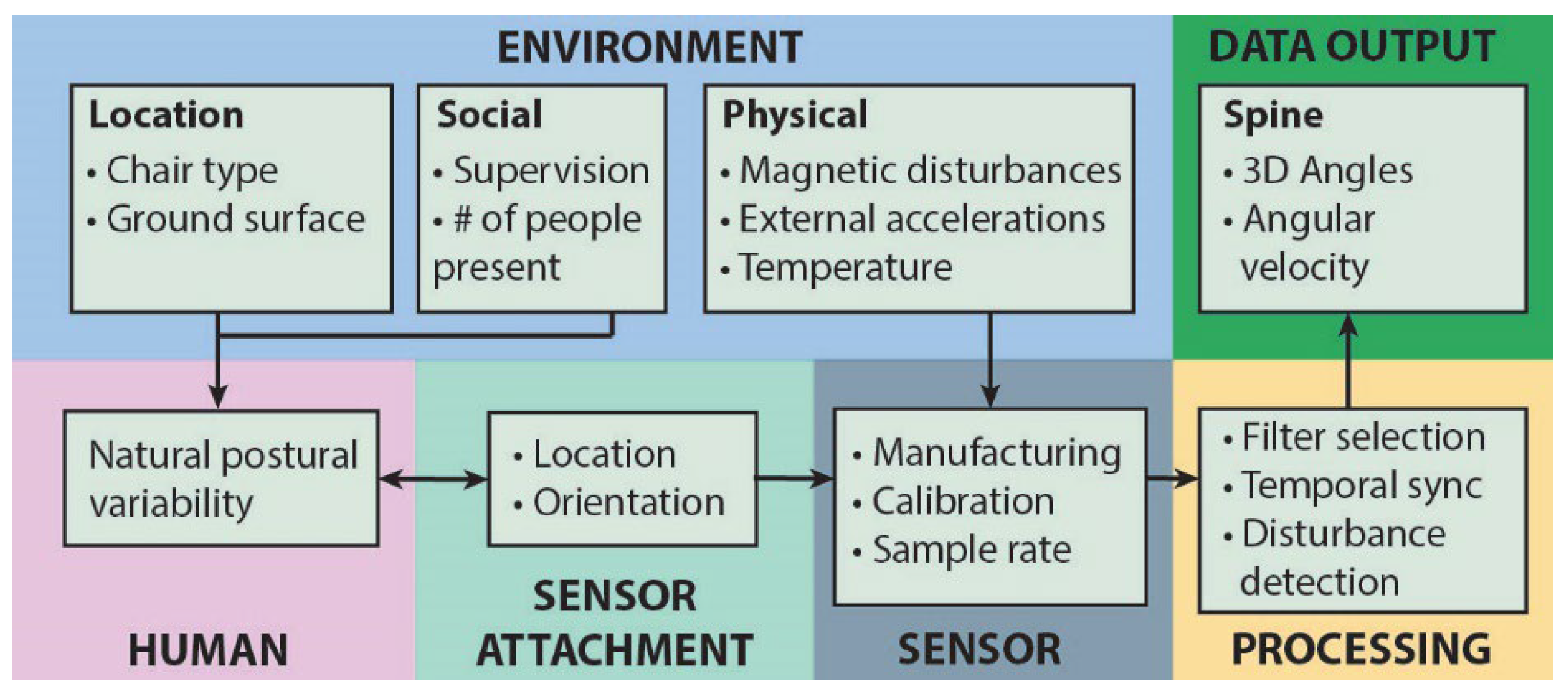
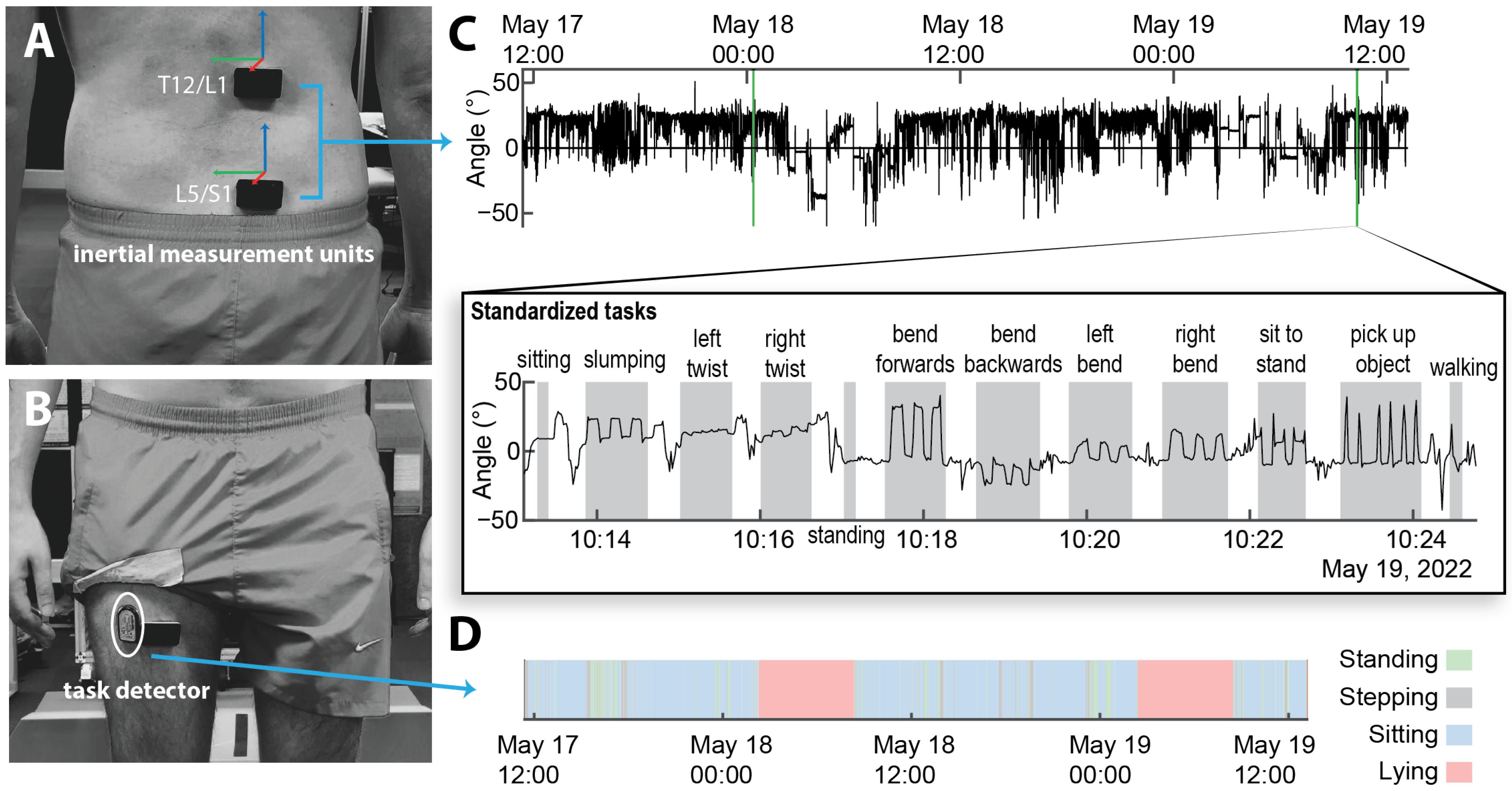
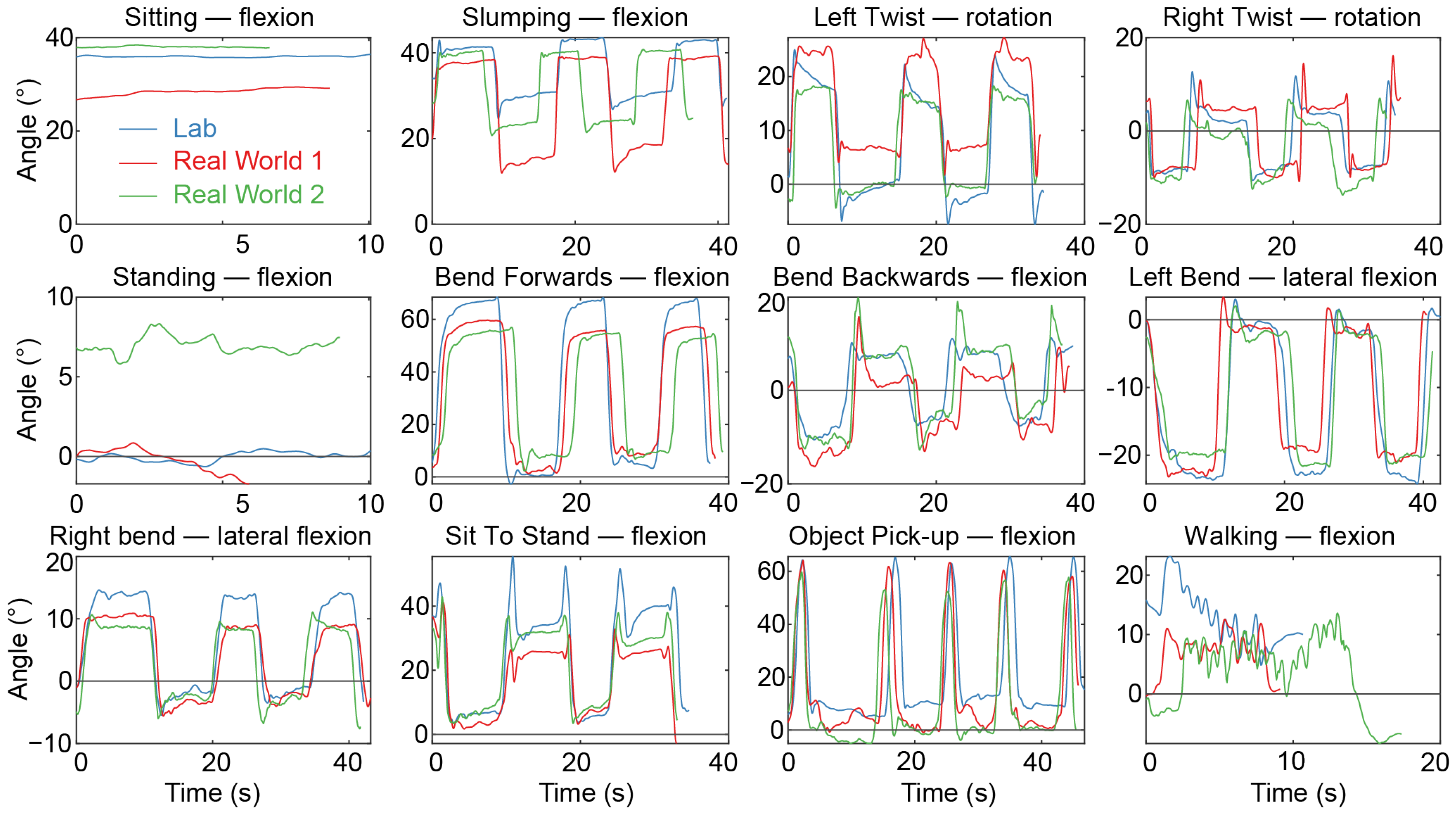

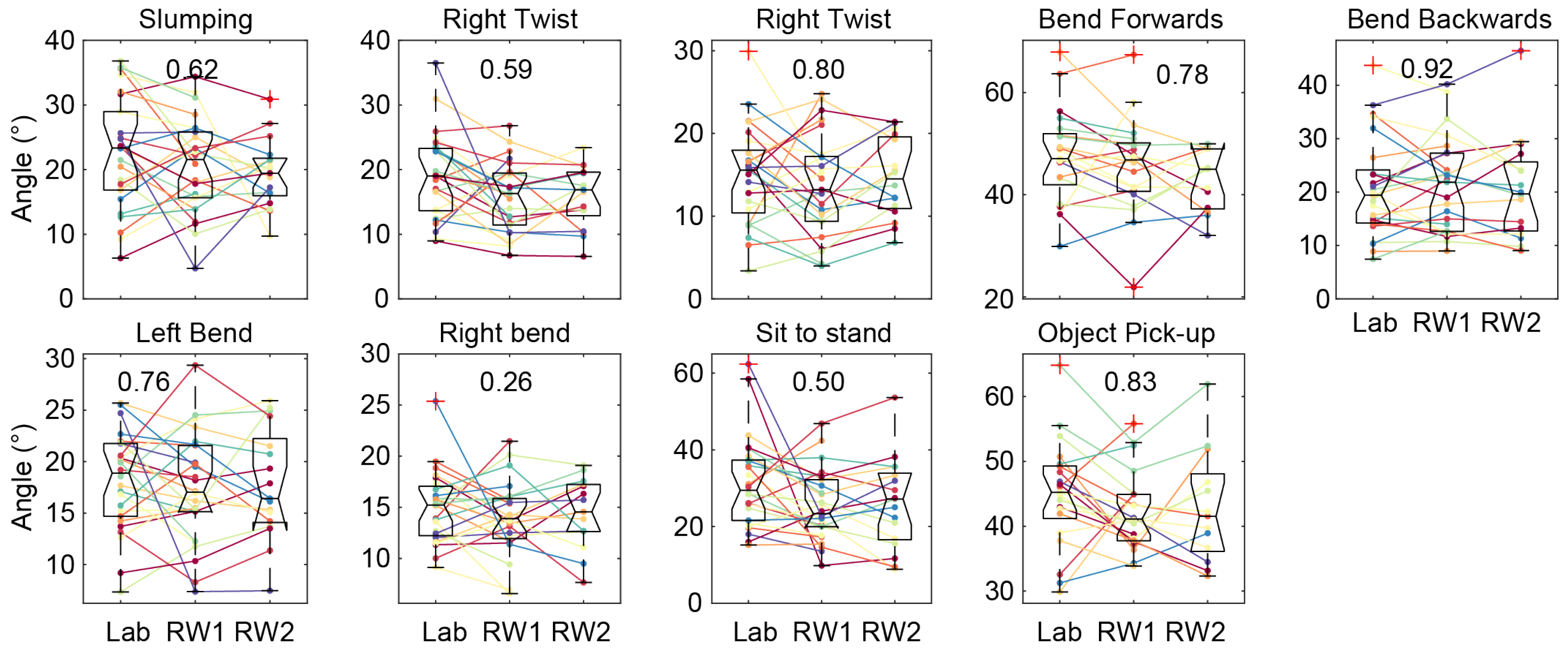

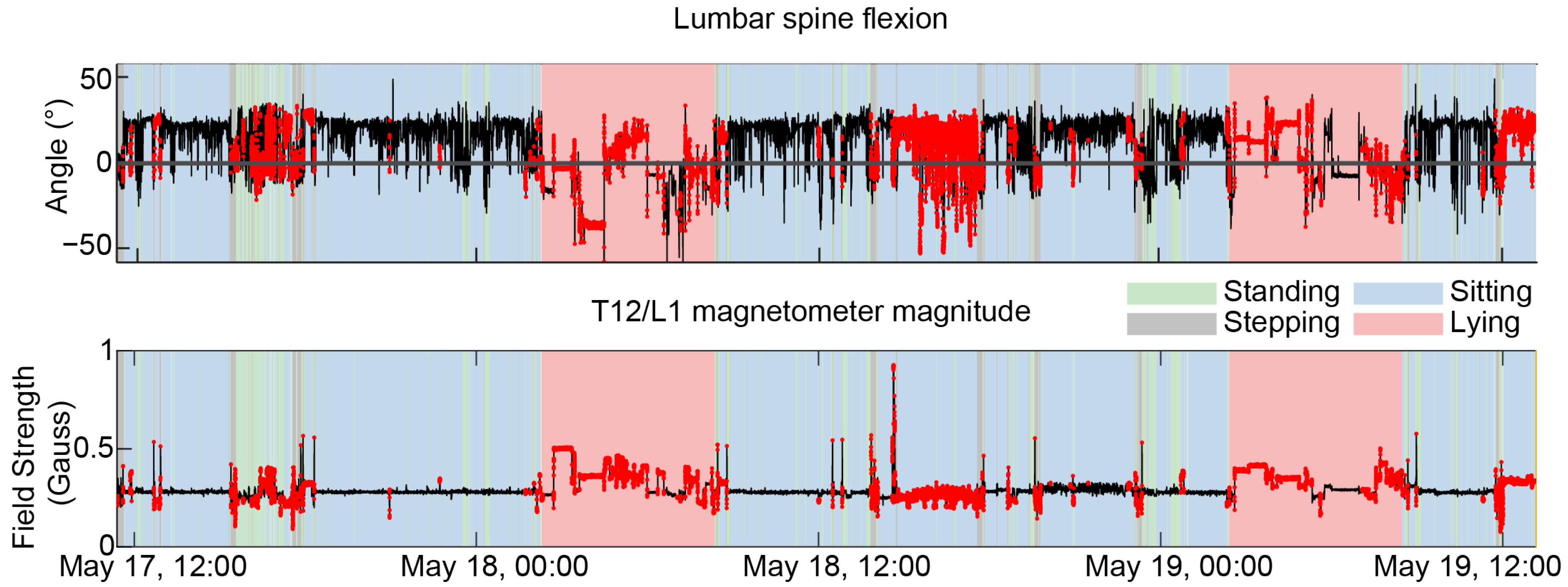
| Movement Type | Posture/Task | Description/Instruction | Time/Reps |
|---|---|---|---|
| Standing | Standing | Stand “normally” with arms crossed over the chest, hands touching the opposite shoulders. | 10 s |
| Bending backwards (flexion ROM) | Stand (arms down), then bend the trunk forwards from the hips, then return to upright. | 3 reps | |
| Bending forwards (extension ROM) | Stand (arms down), then bend the trunk backwards from the hips, then return to upright. | 3 reps | |
| Left bend (lateral flexion ROM) | Stand (arms down), then bend the trunk leftwards by sliding the left arm down the left leg, then return to upright. | 3 reps | |
| Right bend (lateral extension ROM) | Stand (arms down), then bend the trunk rightwards by sliding the left arm down the left leg, then return to upright. | 3 reps | |
| Sitting | Sitting | Sit “normally” with arms crossed over the chest, hands touching the opposite shoulders. | 10 s |
| Slumping (ROM) | Sit upright (arms crossed), then “naturally” slump the spine, then return to upright. | 3 reps | |
| Right rotation (rotation ROM) | Sit upright (arms crossed), then rotate the trunk to the right, then return to upright. | 3 reps | |
| Left rotation (rotation ROM) | Sit upright (arms crossed), then rotate the trunk to the left, then return to upright. | 3 reps | |
| Transition | Sit to stand | Sit upright (arms crossed), then stand at a “natural” speed, then return to sitting. | 3 reps |
| Object pick-up | Bending forwards to pick up a light object | Stand (arms down), then pick up anobject from the ground with the right arm, then return to upright. | 3 reps |
| Walking | Walking forwards in a straight line | Stand (arms down), then walk at a “natural” speed for 10 s. | 10 s |
| IMU Reference-Calculation Methods | |||||
|---|---|---|---|---|---|
| Lab | Session | Day | Composite | Median Standing | |
| Data type | Standing task | All standardized tasks | All standing as labelled using the ActivPAL sensor data | ||
| Application across time | Mean spine angle during the standardized standing task from the lab session applied to all data | Each recording session (lab and real-world) is referenced separately | For each session and each day, a separate reference is computed | Each recording session (lab and real-world) is referenced separately | Each recording session (lab and real-world) is referenced separately |
| Advantages | Not affected by variation in task execution by participant | Limits errors due to sensor manufacturing and placement on body. |
|
| Does not require user to perform any additional tasks |
| Disadvantages | Susceptible to errors due to differences in the following:
|
| Same as “Session” | Assumes that the person does not exhibit a systematic change in posture across all standardized tasks on different days | Assumes that the overall distribution in spinal postures is similar from day-to-day, leading to errors if otherwise |
| ICC—Reference Method | |||||
|---|---|---|---|---|---|
| Standardized Task | Lab | Session | Day | Median Standing | Composite |
| Sitting | 0.65 | 0.75 | 0.66 | 0.16 | 0.62 |
| Standing | 0.42 | −0.04 | −0.32 | 0.07 | 0.75 |
| Walking | 0.45 | 0.63 | 0.51 | 0.56 | 0.66 |
| Slumping | 0.77 | 0.86 | 0.80 | 0.69 | 0.83 |
| Left rotation | 0.76 | 0.89 | 0.80 | 0.66 | 0.91 |
| Right rotation | 0.82 | 0.90 | 0.81 | 0.74 | 0.93 |
| Bend forwards | 0.71 | 0.75 | 0.87 | 0.41 | 0.71 |
| Bend backwards | 0.70 | 0.71 | 0.57 | 0.44 | 0.50 |
| Left bend | 0.55 | 0.76 | 0.48 | 0.02 | 0.60 |
| Right bend | 0.64 | 0.67 | 0.32 | 0.08 | 0.40 |
| Sit To Stand | 0.83 | 0.87 | 0.78 | 0.67 | 0.91 |
| Object Pick-up | 0.59 | 0.76 | 0.68 | −0.35 | 0.78 |
| Mean | 0.66 | 0.71 | 0.58 | 0.35 | 0.72 |
Disclaimer/Publisher’s Note: The statements, opinions and data contained in all publications are solely those of the individual author(s) and contributor(s) and not of MDPI and/or the editor(s). MDPI and/or the editor(s) disclaim responsibility for any injury to people or property resulting from any ideas, methods, instructions or products referred to in the content. |
© 2025 by the authors. Licensee MDPI, Basel, Switzerland. This article is an open access article distributed under the terms and conditions of the Creative Commons Attribution (CC BY) license (https://creativecommons.org/licenses/by/4.0/).
Share and Cite
Riddick, R.; Alshehri, M.A.; Hodges, P. Repeatability of Inertial Measurements of Spinal Posture in Daily Life. Sensors 2025, 25, 5011. https://doi.org/10.3390/s25165011
Riddick R, Alshehri MA, Hodges P. Repeatability of Inertial Measurements of Spinal Posture in Daily Life. Sensors. 2025; 25(16):5011. https://doi.org/10.3390/s25165011
Chicago/Turabian StyleRiddick, Ryan, Mansour Abdullah Alshehri, and Paul Hodges. 2025. "Repeatability of Inertial Measurements of Spinal Posture in Daily Life" Sensors 25, no. 16: 5011. https://doi.org/10.3390/s25165011
APA StyleRiddick, R., Alshehri, M. A., & Hodges, P. (2025). Repeatability of Inertial Measurements of Spinal Posture in Daily Life. Sensors, 25(16), 5011. https://doi.org/10.3390/s25165011






